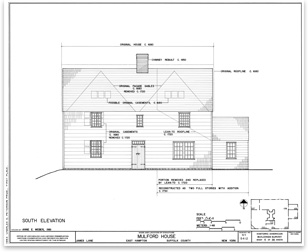
Historic American Buildings Survey Celebrates 75 Years as Invaluable Design Resource by Steve Freeman
How do you . . . augment your design by using the largest single public archive of architectural, engineering, and landscape technical drawings? Presentations from HABS See what the AIA Historic Resources Committee is up to. Drawings from the HABS collection on the 17th-century Mulford House, East Hampton, N.Y, for which, in 1983, Weber received the inaugural Charles E. Peterson Prize, which recognizes the best set of parametric drawings submitted by an architecture student. Need Greek Revival details? Pursuing a job to make a green retrofit to a favorite historic hotel? The Library of Congress can possibly help. Its HABS collection offers online visitors authoritative and high-quality drawings of interiors and exteriors that can be perused online or downloaded. Many entries also include large-format TIF photos of the structures, color transparencies, and other basic documentation. In a few clicks on the Internet, an architect can access the largest public digitized collection of historic U.S. structures and spaces that exists. In-person visits to the collection in the nation’s capital are also possible. The Web site’s search engine is the gateway to the first federal historic preservation program, which today contains 38,500 standardized surveys that are searchable by keyword, geographic identifiers, styles, or materials used. “It’s a very useful tool, good for renovation, construction, and design development,” said Marilyn Ibach, reference specialist in architecture of the library’s Prints and Photographs Division.“ Area, local, and state preservation groups may provide information and even drawings needed by architects doing research, but this online collection is a must-visit site with its 62,000 downloadable, rights-free drawings. It’s fast, free, and convenient.”
“It’s the only place to go to look for graphic documentation of historic buildings, added Weber. “Many are really beautiful and it’s interesting to leaf through them. It’s certainly valuable to architects, because there are more and more historic buildings every day, and the amount of work [you can access] dealing with existing buildings, whether or not they are historic, is a huge plus for architects.” In 1983, Weber was the first recipient of the Department of Interior’s Charles E. Peterson Prize, which recognizes the best set of parametric drawings submitted by an architecture student. Her entry—a hand-drawn treatment of the 17th Century Mulford House in East Hampton, N.Y—was completed while she was a student at Columbia University. Today, she is senior associate for Farewell Mills Gatsch Architects in Princeton, N.J. Connections to the AIA and architects |
||
Copyright 2008 The American Institute of Architects. All rights reserved. Home Page |
||
Photos
1. Anne Weber
2-4 Drawings: From the HABS collection on the 17th-century Mulford House, East Hampton, N.Y, for which, in 1983, Weber received the inaugural Charles E. Peterson Prize, which recognizes the best set of parametric drawings submitted by an architecture student.

 Summary:
Summary: Seamless seques to HAER and HALS
Seamless seques to HAER and HALS